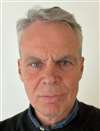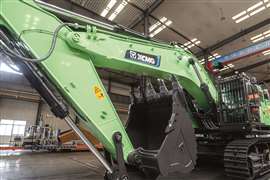What are XCMG’s export priorities?
21 January 2025
Chinese manufacturer XCMG made a big showing at the Bauma China exhibition in Shanghai in late November. It was a good place to find out more about the company’s export strategy, and its response to possible US import tariffs.
XCMG’s Hanson Liu, speaking to Construction Briefing on the second day of Bauma China, is keen to play down the comments on tariffs made by President-elect Trump the day before the show opened.
“Fortunately, it’s only a small portion of the market for us,” he says, “[The USA] is not our biggest market. It’s not even the second largest one.”
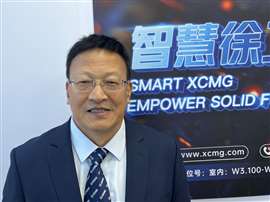 Hanson Liu, vice president of XCMG Construction Machinery Co Ltd, pictured at Bauma China. (Photo: Construction Briefing)
Hanson Liu, vice president of XCMG Construction Machinery Co Ltd, pictured at Bauma China. (Photo: Construction Briefing)
Of course, as a vice president of the Chinese manufacturer and general manager of its import and export division, Liu is very aware of the importance of the USA. The company has previously said that Europe and North America will represent 25% to 30% of its total exports by 2027, with exports reaching half of all revenues.
In support of that aim, the OEM already has a factory in Monterrey, Mexico, and in early 2024 announced it was investing in a second facility in the country.
What tariffs will come under the new US administration are still not known, so it is not fair to expect a detailed plan from the company. However, Liu, who joined XCMG more than a decade ago as an IT specialist, makes it clear - in diplomatic language - that he believes consumers do not benefit from high tariffs.
He says they increase prices, hinder competition on technology and, ultimately, lead to “poor customer satisfaction… They transfer the tariff burden to the customer. And because the customer cannot get the right product, they compete less well in their market.”
Liu places the discussion in the context of how Chinese manufacturers have evolved in their export strategies, with the initial focus on price then shifting to service, and finally moving towards competition on technology.
He thinks that ‘technology’ stage has been reached. Few who walked the Bauma China show last November would argue with that, with Chinese suppliers clearly matching their Western counterparts when it comes to new power technologies such as electrification and hydrogen fuel cells.
‘Internationalisation is localisation’
Higher tariffs will be an issue that XCMG and other Chinese manufacturers will have to address. And while the focus, understandably, is on what is going to happen in the US, Liu is keener to make a wider point about the manufacturer’s strategy.
“We have a facility in Mexico, in Brazil, in India, in Germany”, he says, “We are globalised. We strongly believe that internationalisation is localisation.
“We are a global brand that localises its resources as much as possible. We say local people, local marketing people, designers, engineering. For example, in India we have almost 100% Indian people. We can export technology, and export investment.”
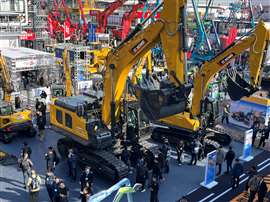 Excavators on XCMG’s stand at Bauma China. (Photo: Construction Briefing)
Excavators on XCMG’s stand at Bauma China. (Photo: Construction Briefing)
Regarding Europe, there are discussions between the European Union and China on minimum pricing arrangements for electric vehicles, as an alternative to tariffs. Could such an approach work on construction equipment?
He responds by saying that Chinese OEMs are already manufacturing products in Europe, and that in consumer goods and EVs, European brands have been very successful in China; “European car manufacturers have worked in China for many years and earned a lot of money. Why can’t you enjoy some Chinese-made cars? The market works both ways - we work together.”
If the US market is where uncertainty lies, XCMG is still forging ahead in other areas of the world. The current priorities are Indonesia and the Middle East, where manufacturing facilities are now being planned.
It will also expand its footprint in Uzbekistan, where it has had a manufacturing facility for 10 years already, and possibly Pakistan. It also has a mining truck assembly line in Nigeria.
What is the plan for Indonesia? “I think it is under investigation, how to make it happen soon. We already made this part of our strategy.”, he says. That facility would focus initially on electric mining trucks.
For the Middle East, Saudi Arabia is option being looked at, and that plant would be for excavators.
“The logistics cost is a big factor for heavy machinery”, says Liu, “It’s not logical to export a lot of counterweights, structures. The space, the weight, the cost; sometimes it is not sensible for an OEM to produce in one manufacturer plant.”
Committed to aerial platforms?
One new area for the business is aerial platforms - the self-propelled booms and scissors that are so popular with the world’s equipment rental companies.
“AWP definitely is one of our leading emerging new business sectors”, says Liu, “We continue investing. It’s good for our electric technology, new energy.
“That’s our main investment. This is a big commitment to our customers. We’ll grow this business.”
In addition to its Chinese manufacturing facilities for MEWPs, it is also producing lifts in Mexico; “Now it is already up to 50% localized in Mexico”, he says, “Local procurement and local labour.”
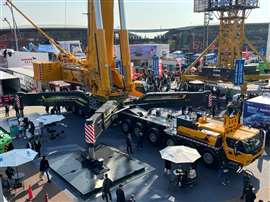 XCMG’s massive XCA4000 crane pictured at the 2024 Bauma China show. (Photo: Construction Briefing)
XCMG’s massive XCA4000 crane pictured at the 2024 Bauma China show. (Photo: Construction Briefing)
The investment in electric AWPs is just part of XCMG’s investment in new power technology. XCMG benefits in this area from a battery manufacturing joint venture with BYD, the Chinese car maker and battery producer.
Liu sees China’s advanced battery supply chain as giving its OEMs an advantage in the global market; “Definitely we have an advantage over other competitors because we have integrated our supply chain for electric equipment. We have our own joint venture with BYD for battery cell manufacturing.
“We have our own battery pack plant. We have our own team for battery management systems, we have our own motors plant, in Dalian.
“We have the charger, we have electric cylinders, electric axles, reducer. We can do that by ourselves and that’s why we can move faster than any other manufacturers.”
Growth in electric equipment
China is the biggest current market for electric construction and mining equipment, largely for mid- and large-sized wheeled loaders which are used at quarries and other fixed locations, where charging is relatively easy.
Even so, electric machines still only represent around 5% of all of XCMG’s machine sales. “But it’s growing very fast”, says Liu, “And our export growth of electric machines is around 280%. That’s from a small number but is growing fast.”
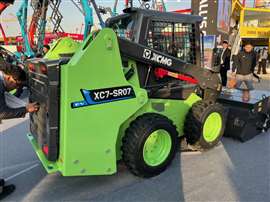 This XC7-SR07 skid steer loader was one of the all-electric machines on show on the XCMG stand. (Photo: Construction Briefing)
This XC7-SR07 skid steer loader was one of the all-electric machines on show on the XCMG stand. (Photo: Construction Briefing)
Liu says the driver is not just the environmental benefit – lower carbon emissions – but a lower total cost of ownership; “TCO is much lower. That’s the main driver.”
How quickly will XCMG’s sales of electric machines grow? What will the proportion be in three years?
“I think maybe 20 to 30%. It could be 50% for some small machines”, he says, “For example, small loaders, it could be much faster in China. Maybe within the next five years there will be no diesel loaders.”
Of course, the investment in export markets comes at a difficult time for the Chinese construction equipment market. Total annual sales reached a peak in 2020 and 2021 – more than 450,000 units - because of government stimulus efforts, but have since dropped to less than 200,000, according to Off-Highway Research.
“Fortunately, we saw very favourable signs in October”, says Liu, “The working hours of the existing population of machines was higher than the first nine months. And also, sales in October were higher than previous months this year [in 2024]. October was a big surprise to all of us. It’s rebounding.”
It may indeed be rebounding, but export growth will remain a key component in XCMG’s growth strategy. That was clear at Bauma China, where it hosted some 800 foreign customers.
It is also likely to be very evident at the Bauma exhibition in Munich this April, where XCMG is expected to make a big showing. And if the worst fears about US tariffs are realised, it may be that Europe becomes an even higher priority for the company.
STAY CONNECTED



Receive the information you need when you need it through our world-leading magazines, newsletters and daily briefings.
CONNECT WITH THE TEAM






